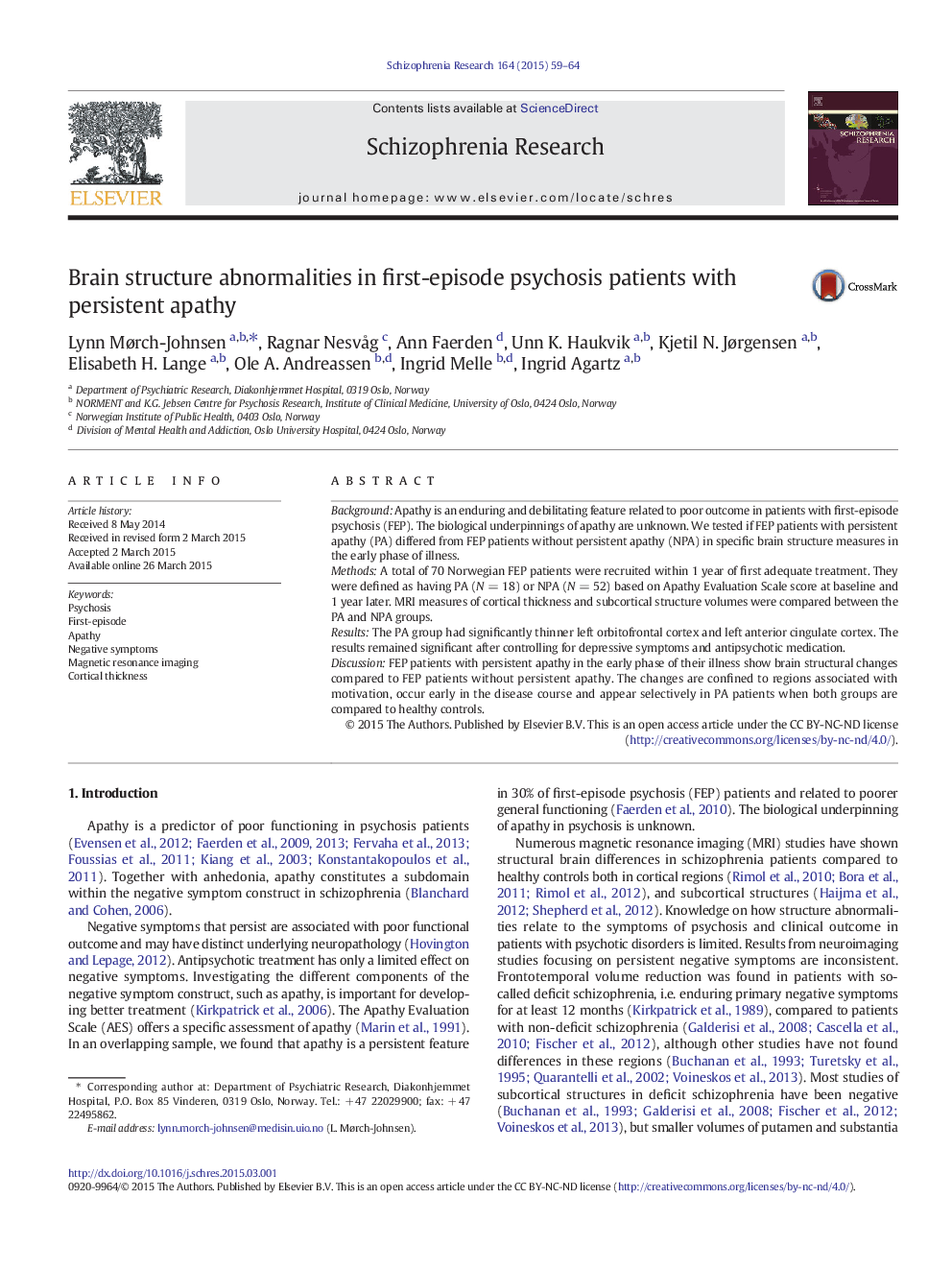Apathy is a predictor of poor functioning in psychosis patients (Evensen et al., 2012, Faerden et al., 2009, Faerden et al., 2013, Fervaha et al., 2013, Foussias et al., 2011, Kiang et al., 2003 and Konstantakopoulos et al., 2011). Together with anhedonia, apathy constitutes a subdomain within the negative symptom construct in schizophrenia (Blanchard and Cohen, 2006).
Negative symptoms that persist are associated with poor functional outcome and may have distinct underlying neuropathology (Hovington and Lepage, 2012). Antipsychotic treatment has only a limited effect on negative symptoms. Investigating the different components of the negative symptom construct, such as apathy, is important for developing better treatment (Kirkpatrick et al., 2006). The Apathy Evaluation Scale (AES) offers a specific assessment of apathy (Marin et al., 1991). In an overlapping sample, we found that apathy is a persistent feature in 30% of first-episode psychosis (FEP) patients and related to poorer general functioning (Faerden et al., 2010). The biological underpinning of apathy in psychosis is unknown.
Numerous magnetic resonance imaging (MRI) studies have shown structural brain differences in schizophrenia patients compared to healthy controls both in cortical regions (Rimol et al., 2010, Bora et al., 2011 and Rimol et al., 2012), and subcortical structures (Haijma et al., 2012 and Shepherd et al., 2012). Knowledge on how structure abnormalities relate to the symptoms of psychosis and clinical outcome in patients with psychotic disorders is limited. Results from neuroimaging studies focusing on persistent negative symptoms are inconsistent. Frontotemporal volume reduction was found in patients with so-called deficit schizophrenia, i.e. enduring primary negative symptoms for at least 12 months (Kirkpatrick et al., 1989), compared to patients with non-deficit schizophrenia (Galderisi et al., 2008, Cascella et al., 2010 and Fischer et al., 2012), although other studies have not found differences in these regions (Buchanan et al., 1993, Turetsky et al., 1995, Quarantelli et al., 2002 and Voineskos et al., 2013). Most studies of subcortical structures in deficit schizophrenia have been negative (Buchanan et al., 1993, Galderisi et al., 2008, Fischer et al., 2012 and Voineskos et al., 2013), but smaller volumes of putamen and substantia nigra (Cascella et al., 2010) have been reported. Reduced gray matter volumes in frontal orbital gyrus and parahippocampal gyrus in FEP patients with persistent negative symptoms, i.e. presence of negative symptoms for 6 months in a stable period of psychosis (Buchanan, 2007) have been reported (Benoit et al., 2012). Inconsistencies in findings could be due to variation of MR methods, use of different regions of interest and underpowered samples.
Neither the definition of deficit schizophrenia, nor the broader definition of persistent negative symptoms considers the different subdomains of the negative symptom construct. There is only one published study of the relationship between brain structure and level of apathy in psychosis patients. Roth et al. (2004), found smaller frontal lobe volumes in chronic schizophrenia patients with high apathy levels compared with low apathy patients.
In patients with Alzheimer's disease, apathy has been related to the orbitofrontal cortex (OFC) and the anterior cingulate cortex (ACC) (Guimaraes et al., 2008, Tunnard et al., 2011 and Stanton et al., 2013). A correlation between apathy and smaller gray matter volumes of the caudate and putamen has also been reported (Bruen et al., 2008). Apathy has been observed in patients with lesions in basal ganglia (Bhatia and Marsden, 1994) and thalamus (Ghika-Schmid and Bogousslavsky, 2000 and Carrera and Bogousslavsky, 2006).
To search for brain structural markers of persistent apathy in psychosis patients we tested if preselected brain regions differed between FEP patients with persistent apathy (PA) compared to FEP patients without persistent apathy (NPA). Measures of cortical thickness and subcortical structure volumes were obtained by MRI within a year after start of first adequate treatment. First, based on findings from studies of Alzheimer's disease (Guimaraes et al., 2008, Tunnard et al., 2011 and Stanton et al., 2013) and brain lesions (Bhatia and Marsden, 1994, Ghika-Schmid and Bogousslavsky, 2000 and Carrera and Bogousslavsky, 2006), we hypothesized that the PA group shows cortical thinning in OFC and ACC and reduced basal ganglia (caudate, putamen, pallidum, and accumbens) and thalamus volumes. Second, due to the limited number of studies on the topic, we explored group differences in cortical thickness across the entire cortical surface, and in all available subcortical structure volumes (hippocampus, amygdala, ventricles, and cerebellum) that were not included in the hypothesis-driven analyses.


